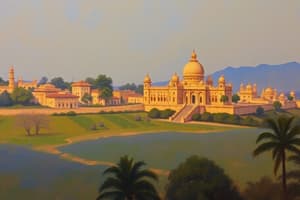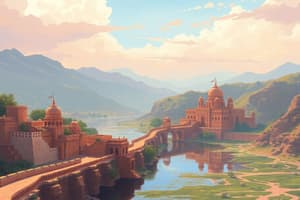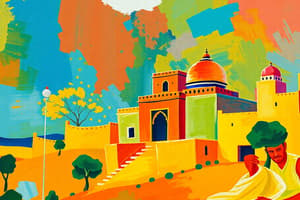Podcast
Questions and Answers
Which of the following cities in Rajasthan is known for its lakeside palaces and tourist attractions?
Which of the following cities in Rajasthan is known for its lakeside palaces and tourist attractions?
- Udaipur (correct)
- Jodhpur
- Jaisalmer
- Jaipur
What is the primary religious faith in Rajasthan?
What is the primary religious faith in Rajasthan?
- Hinduism (correct)
- Islam
- Buddhism
- Sikhism
Besides Hindi, which other language is widely spoken in Rajasthan?
Besides Hindi, which other language is widely spoken in Rajasthan?
- Marathi
- Rajasthani (correct)
- Gujarati
- Bengali
Which of the following is NOT a feature of Rajasthan's demographic makeup?
Which of the following is NOT a feature of Rajasthan's demographic makeup?
What is the administrative head of each district in Rajasthan?
What is the administrative head of each district in Rajasthan?
Which of these statements accurately reflects the geographical features of Rajasthan?
Which of these statements accurately reflects the geographical features of Rajasthan?
Which of the following contributed most significantly to the development of Rajasthan's rich historical legacy?
Which of the following contributed most significantly to the development of Rajasthan's rich historical legacy?
What best describes the cultural influence of the Rajputana traditions in Rajasthan?
What best describes the cultural influence of the Rajputana traditions in Rajasthan?
Which of the following factors is LEAST significant in shaping the economic landscape of Rajasthan?
Which of the following factors is LEAST significant in shaping the economic landscape of Rajasthan?
Which of the following BEST describes the role of the southwest monsoon in Rajasthan's climate?
Which of the following BEST describes the role of the southwest monsoon in Rajasthan's climate?
Which of the following regions was NOT a significant kingdom in Rajasthan's history?
Which of the following regions was NOT a significant kingdom in Rajasthan's history?
What is a key distinguishing feature of Rajasthani culture, particularly in the context of textiles and costumes?
What is a key distinguishing feature of Rajasthani culture, particularly in the context of textiles and costumes?
Which of the following BEST exemplifies the impact of Rajasthan's history on its present-day economy?
Which of the following BEST exemplifies the impact of Rajasthan's history on its present-day economy?
Flashcards
Rajasthan
Rajasthan
The largest state in India located in northwestern India, bordering Pakistan.
Thar Desert
Thar Desert
A major desert in Rajasthan, also called the Great Indian Desert.
Aravalli Range
Aravalli Range
A major north-south mountain range in Rajasthan.
Rajasthan Climate
Rajasthan Climate
Signup and view all the flashcards
Historical Kingdoms
Historical Kingdoms
Signup and view all the flashcards
Rajputana Culture
Rajputana Culture
Signup and view all the flashcards
Economy of Rajasthan
Economy of Rajasthan
Signup and view all the flashcards
Key Crops in Rajasthan
Key Crops in Rajasthan
Signup and view all the flashcards
Renewable Energy Opportunities
Renewable Energy Opportunities
Signup and view all the flashcards
Rajasthan Population
Rajasthan Population
Signup and view all the flashcards
Rajasthan Languages
Rajasthan Languages
Signup and view all the flashcards
Jaipur
Jaipur
Signup and view all the flashcards
District Collector
District Collector
Signup and view all the flashcards
Study Notes
Geography
- Rajasthan is located in northwestern India, bordering Pakistan to the west.
- It is the largest state in India by area.
- The Thar Desert, also known as the Great Indian Desert, is a significant part of Rajasthan.
- The state has diverse geographical features including plains, hills, and valleys.
- Aravalli Range: A major mountain range running roughly north-south across the state.
- Key rivers: Luni River, Banas River, and other smaller streams.
- Rainfall patterns are primarily influenced by the southwest monsoon.
- Climate: Generally hot and arid, with large variations in temperature throughout the year.
History
- Rajasthan is known for its rich and diverse history, with many kingdoms and principalities existing for centuries.
- The region was a significant center of ancient civilizations, as seen through archaeological discoveries.
- Historical evidence suggests various rulers governed distinct regions at different times.
- Significant kingdoms include Mewar, Marwar, Jodhpur, Jaipur, and others. These kingdoms played important roles in regional politics and trade networks.
- Many battles and conflicts occurred throughout the region as various dynasties fought for control.
- The incorporation of Rajasthan into British India marked a pivotal moment in its history.
- Historical sites, forts, and palaces are prevalent throughout Rajasthan.
Culture
- Rajasthan is widely known for its vibrant culture.
- Distinct folk traditions, customs, and rituals are associated with specific regions and kingdoms.
- Unique costumes and textiles are common, known for their intricate designs.
- Music and dance forms, both classical and folk, reflect the diverse cultural influences through the region.
- Religious traditions are diverse, with Hinduism being a prominent faith.
- The traditions of Rajputana are significant cultural elements.
- Rajput martial traditions and values are still influential in present-day Rajasthan.
Economy
- The economy of Rajasthan relies heavily on agriculture, tourism, and services.
- Agricultural sectors cover significant parts of the populace.
- Key agricultural products and crops include grains, pulses, and sugarcane.
- Livestock farming is also a significant economic activity.
- Tourism has greatly increased, with many historical monuments and palaces attracting tourists.
- Industries, including mining and manufacturing, contribute to the economy, though to a lesser degree than tourism and agriculture.
- Opportunities in new sectors like renewable energy are emerging.
Demographics
- Rajasthan has a sizeable population, and its density varies across districts.
- The state has a significant rural population.
- Languages spoken include Hindi, Rajasthani, and other local dialects.
- Religious diversity exists, with Hinduism being the predominant faith.
- A notable feature is a unique social structure formed by traditional caste systems, although there has been significant social change over the years.
- Education and literacy rates are important factors in the demographic makeup.
- Significant migration patterns across the state impact the population and demographics.
Important Cities
- Jaipur: The capital of Rajasthan, famous for its forts, palaces, and overall architecture.
- Jodhpur: Another significant city, known for its Mehrangarh Fort.
- Udaipur: Famous for its lakeside palaces and tourist attractions.
- Other notable cities include Jaisalmer, Bikaner, and Kota. Each has its own unique features, historical sites, and economic importance.
Administration
- Rajasthan is divided into administrative districts.
- Each district has its own administrative structure and is led by a district collector.
- The state operates through a hierarchical system of governance and administration, following Indian policies.
Studying That Suits You
Use AI to generate personalized quizzes and flashcards to suit your learning preferences.




